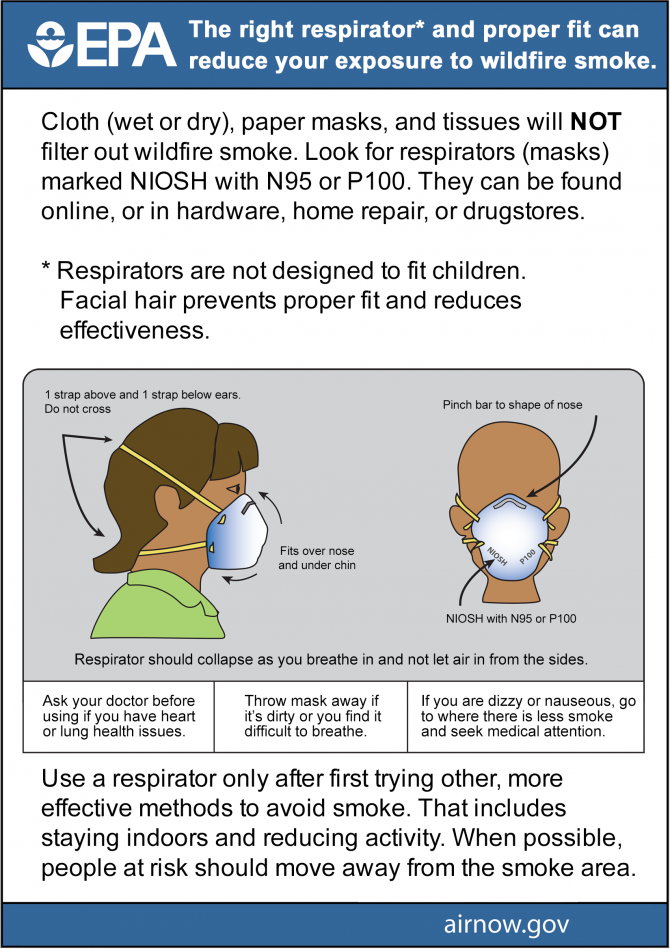Many experts are predicting that given widespread drought in California, we're likely to have a nasty fire season. The Cal Fire website states that
"the fire season in California and across the West is starting earlier and ending later each year. Climate change is considered a key driver of this trend. Warmer spring and summer temperatures, reduced snowpack, and earlier spring snowmelt create longer and more intense dry seasons that increase moisture stress on vegetation and make forests more susceptible to severe wildfire"
Preparation is key. While the Bay Area might be less likely to be directly threatened by fire and subject to evacuation compared to neighboring counties, we will almost certainly need to deal with crises such as smoky air and PG&E's Public Safety Power Shut-Offs (PSPS).
The earlier you start to prepare the better, because once fire and poor air quality become an issue it might be more difficult to obtain supplies.
Protecting Yourself From Smoke and Ash
Wildfire smoke is made up of gases and tiny particles from burning materials, and you definitely don't want it in your lungs. The effects of breathing it in can include symptoms as mundane as a scratchy throat, wheezing, and stinging eyes, and as unpleasant and scary as headaches, chest pain, and a racing heart.
According to the CDC, the best way to protect against the potentially harmful effects of wildfire smoke is to reduce your exposure by staying indoors or in a cleaner air shelter.
- Keep an eye on air quality using AirNow.org and/or sign up for alerts from the Bay Area Air Quality Management District (BAAQMD) to get a text when air quality becomes unhealthy in your area
- If possible, stock up on supplies of medicine and food so that you can avoid errands outside the home
- Once air quality is bad, eliminate outdoor exercise or do low-intensity activities
I f you absolutely have to be outside or in smoky areas, wearing a properly fitted N95 or P100 mask (also known as respirator) can help.
f you absolutely have to be outside or in smoky areas, wearing a properly fitted N95 or P100 mask (also known as respirator) can help.
- This infographic shows how to identify the right kind of mask and make sure it fits properly
- This EPA fact sheet (PDF download) on protecting your lungs from wildfire smoke gives more information on when and how to wear respirators
- However, know that a properly fitted N-95 respirator makes it difficult to breathe and is difficult to use for long periods of time. (Source)
Keeping Smoke Out of Your Home
The Environmental Protection Agency (EPA) has an excellent guide to creating a "cleaner air space" inside your home so that you and your family are protected from exposure to smoke.
Some important points:
- Consider purchasing a portable air cleaner (or "purifier") or high-efficiency HVAC Filter.
- You can also go the "do-it-yourself" route by attaching a filter to a box fan as in this video (link approved by the EPA):
- Know how to adjust your HVAC system or air conditioner to keep smoke out
- Keep an eye on air quality and air out your home when air quality improves
- Avoid activities that create air pollution indoors, for example smoking, vacuuming, or burning candles
The BAAMQD page on preparing for wildfire smoke additionally suggests weatherizing your home in preparation for wildfires by replacing or refurbishing old leaky windows and doors; use caulking to seal the openings. This SFGate article also recommends using weatherstripping to seal off gaps around doors and windows through which smoke seeps in.
Smoke Inhalation or COVID-19?
There are some special considerations to dealing with wildfires and their attendant dangers during COVID-19, and the CDC goes over them here.
Important points (learn more in the above linked page):
- Get vaccinated for COVID-19, if you haven't already. Wildfire smoke can irritate your lungs, airways, and immune system in ways that make you more likely to get lung infections, such as COVID-19. And vice versa, having COVID-19 can make the effects of inhaling wildfire smoke much worse.
- Know the difference between symptoms from smoke exposure and COVID-19
- Symptoms like fever or chills, muscle or body aches, and diarrhea are not related to smoke exposure. If you have any of these symptoms, the CDC COVID-19 Self-Checker can help you determine whether you need further assessment or testing for COVID-19
Losing Electric Power During Public Safety Power Shut-Offs (PSPS)
As in previous years, PG&E is planning on trying to mitigate wildfire risk by shutting power to regions deemed at high-risk due to heat and wind. Learn more about what PSPS are, and how PG&E will notify you if there's one in your area.
- Make sure you're getting PSPS and outage alerts
- Prepare for a PSPS by considering your food, medicine, technology, and safety needs as outline in PG&E's guide
- Consider setting up a source of backup power
- Do you rely on electrical power for medical needs? Sign up for PG&E's Medical Baseline Program (which can be required for other services)
Preparing Your Home and Family for Fire
In case fire does threaten your home, it is imperative to have taken precautions ahead of time and be prepared to evacuate.
Watch a presentation on Fire Smart Landscaping from Marin's Master Gardeners:
Other resources to help you prepare:
- CalFire's Ready for Wildfire extremely useful site has text alerts you can sign up for as well as information on long-term planning, such as creating defensible space, home hardening, and evacuation planning tools
- Ready.gov similarly has easy to follow, step by step instructions on how to prepare, from getting alerts from local agencies to putting together a "go" bag



Add a comment to: Preparing for Wildfire Season